-

新人教版高中英语必修3Unit 4 Space Exploration-Listening&Speaking&Talking教学设计二
The themes of this part are “Talk about how to become an astronaut” and “Talk about life in space”. As Neil Armstrong said “Mystery creates wonder and wonder is the basis of man’s desire to understand. Space is difficult for human to reach, therefore, humans are full of wonders about it. However, if wanting to achieve the dream of reaching the Moon, some of our human should work hard to be an astronaut at first. Part A(Talk about how to become an astronaut) is a radio interview in a radio studio, where the host asked the Chinese astronauts about his story how to become an astronaut. Yang Liwei told his dreamed to be an astronaut since childhood. Then he worked hard to get into college at 22. The next 10 years, he gradually became an experienced pilot. At the same time, to be an astronaut, he had to study hard English, science and astronomy and trained hard to keep in good physical and mental health and to practise using space equipment. Part B (Talk about life in space) is also an interview with the astronaut Brown, who is back on the earth. The host Max asked about his space life, such as his emotion about going back the earth, the eating, shower, brushing, hobbies and his work. Part A and Part B are interviews. So expressing curiosity about the guests’ past life is a communicative skill, which students should be guided to learn.1. Students can get detailed information about how Yang Liwei became an astronaut and Max’s space life.2. Students learn to proper listening strategy to get detailed information---listening for numbers and taking notes.3. Students can learn related sentences or phrases to express their curiosity like “ I wish to know...” “I’d love to know...”4. Students can learn more about the space and astronauts, even be interested in working hard to be an astronaut

新人教版高中英语必修3Unit 5 The Value of Money- Discovering Useful Structure教学设计
Step 3 Meaning1. 过去将来时表示从过去某一时间来看将要发生的动作或存在的状态, 常用在宾语从句中。一般由“would/should +动词原形”构成。She hoped that they would meet again someday. 她希望将来有一天他们能再见面。2. was/were going to+动词原形: 表示过去将要发生或很有可能发生的动作, 常用于口语中, 表示预言、意图或者打算等。He was going to start work the following week. 他打算下星期开始工作。3. was/were about to do: 常用来表示即将发生的动作, “刚要/正要做……”。注意该结构不与任何时间状语连用。I felt that something terrible was about to happen. 我感到某种可怕的事情即将发生。4.was/were to do: 表示“曾计划做某事”, 如果表示“本来计划做某事, 动作没实现”, 则需用 “was/were to have done”。She said she was to have told me about the accident. 她说她本来想告诉我关于事故的事。5.Start, go, come, leave, see, meet等动词的过去进行时: 表示就过去某一时刻而言即将发生的动作。She was coming later. 她随后就来。I had just put on my overcoat and was leaving to visit a friend of mine. 我刚穿上外套要去看我的一个朋友。
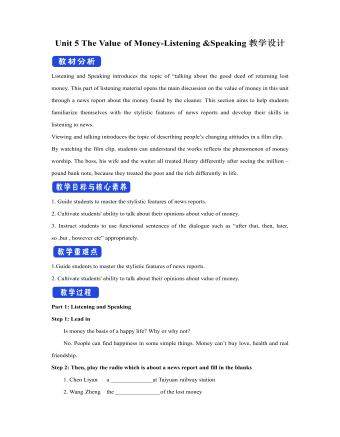
新人教版高中英语必修3Unit 5 The Value of Money-Listening &Speaking教学设计
Step 4: Listen again and decide if the following statements are true (T) or false (F).1 It was the first time Chen Liyan's story was reported. T口 F口2 Chen found 10,000 yuan in a small plastic bag in Taiyuan railway station口 F口3 Wang Zheng apologized to Chen because he couldn't offer her more money. T口 F口4 Chen took out a large loan to cure her daughter, T口 F口5 Wang set up a fundraising website for Chen's daughter after Chen told him about her situation. T口 F口Step 5:After listening, discuss the questions.1 What kind of person do you think Chen Liyan is?Chen Liyan is generous and honest because she returned a large sum of money to the owner.2 Did Chen return the money because she didn't need it?No. She returned the money because it was the right thing to do. Evidence for this is that she refused to accept the reward money because she felt that it had not been earned. 3 Is it common for people to do what Chen did?It depends on the culture. In some countries it is quite common to return money that has been found. In other countries, people believe "Finders are keepers!" 4 How did Wang Zheng feel about the return of his money?He must have been very happy and relieved to have gotten his money back. We know this because he thanked Chen repeatedly and even offered her a reward.5 Why did Ma Dongbao tell Wang about Chen's family?He must have had great sympathy for Chen and her daughter and wanted to help them.'We know this because he arranged help for them. 6 How did the news reporter feel about Chen's actions?The news reporter felt that it showed that money wasn't the most important thing in life. We know this because the reporter told us that this is what Chen believes. and then said, “that's a great attitude to take."
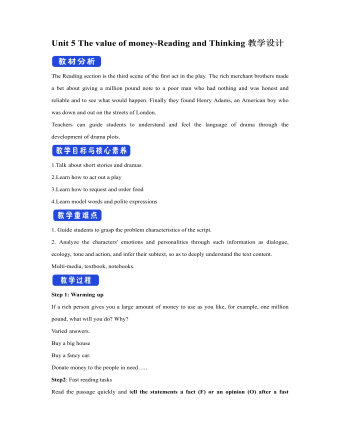
新人教版高中英语必修3Unit 5 The value of money-Reading and Thinking教学设计二
? Could you offer me some kind of work here?? I don’t want your charity, I just want an honest job.? Careless: I landed in Britain by accident.Step 7:Consolidation.? Find Henry? Roderick and Oliver were I .making a bet when they saw Henry, a poor young man. ? Know Henry? About a month ago, Henry was sailing and later he found himself carried out to sea by a strong wind. Fortunately, he 2.was spotted by a ship. And it was the ship that brought him to 3.England? Offer money to Henry ? Oliver and Roderick gave Henry a letter and told him that there was money in it. They 4.persuaded him to accept it, and made him 5.promise that it wouldn't be opened until 2 o'clock.Step 8:Language pointsa large amount of: a large quantity of; a great deal ofe.g. They bought a large amount of furniture before they moved their new house.make a bet: make an arrangement to risk money, etc. on an event of which the result is doubtful.e.g. We made a bet on the result of the match.permit sb to do something: allow somebody to do somethinge.g. My mother doesn’t permit me to ride in the street after it rained.by accident: as a result of chancee.g. I only found it by accident.stare at: look at somebody or something with the eyes wide open in a fixed gaze( in astonishment, wonder, fear, etc)to be honest: to tell you the truth; to be franke.g. To be honest, I don’t think we have a chance of winning.Step7 Homework:What do you think will happen to Henry? Will the bank-note help him or get him into trouble?

新人教版高中英语必修3Unit 5 The Value of Money-Reading for Writing教学设计二
2. 您能看到, 我头发太长了。You can see that my hair is much too long.3. 无论什么时候, 只要您想回来就回来。Please come back whenever you want.4. 您仅有很少的头发要理! You only have too little hair to cut !5. 为您服务是我的荣幸!It is my honour to serve you!Step 9 Writing(Henry is walking down the street when he sees a sign for a place that cuts hair. He decides to have it cut. )H=Henry B=BarberH: Good afternoon, I’d like to have my hair cut, if I may. (The barber looks at Henry’s hair and continues cutting another man’s hair. ) Er, I’d really like a haircut. As you can see it’s much too long. B: (in a rude manner) Yes, I can see that. Indeed, I can. H: Fine, well, I’ll have a seat then. (He sits in one of the barber’s chairs. The barber turns to look at Henry. )B: It’s quite expensive here, you know! Are you sure you can afford it?H: Yes. I think so. (After his hair is cut, the barber tells Henry how much he must pay. Henry shows the barber the bank note. )B: Why Mr. . . (looks shocked)H: Adams. Henry Adams. I’m sorry. I don’t have any change. B: Please don’t worry! (wearing a big smile) Nothing to worry about! Nothing at all! Please come back whenever you want, even if you only have too little hair to cut! It will be my honour to serve you!Step 10 Pair workExchange drafts with a partner. Use this checklist to help your partner revise his/her draft.1. Are all the elements of a play included and in good order ?2. Do the character use suitable language ?3. Are the stage directions clear and useful ?4. Is the plot clear and exciting enough ?

新人教版高中英语选修2Unit 1 Science and Scientists-Discovering useful structures教学设计
The grammatical structure of this unit is predicative clause. Like object clause and subject clause, predicative clause is one of Nominal Clauses. The leading words of predicative clauses are that, what, how, what, where, as if, because, etc.The design of teaching activities aims to guide students to perceive the structural features of predicative clauses and think about their ideographic functions. Beyond that, students should be guided to use this grammar in the context apporpriately and flexibly.1. Enable the Ss to master the usage of the predicative clauses in this unit.2. Enable the Ss to use the predicative patterns flexibly.3. Train the Ss to apply some skills by doing the relevant exercises.1.Guide students to perceive the structural features of predicative clauses and think about their ideographic functions.2.Strengthen students' ability of using predicative clauses in context, but also cultivate their ability of text analysis and logical reasoning competence.Step1: Underline all the examples in the reading passage, where noun clauses are used as the predicative. Then state their meaning and functions.1) One theory was that bad air caused the disease.2) Another theory was that cholera was caused by an infection from germs in food or water.3) The truth was that the water from the Broad Street had been infected by waste.Sum up the rules of grammar:1. 以上黑体部分在句中作表语。2. 句1、2、3中的that在从句中不作成分,只起连接作用。 Step2: Review the basic components of predicative clauses1.Definition

新人教版高中英语选修2Unit 4 Journey Across a Vast Land教学设计
当孩子们由父母陪同时,他们才被允许进入这个运动场。3.过去分词(短语)作状语时的几种特殊情况(1)过去分词(短语)在句中作时间、条件、原因、让步状语时,相当于对应的时间、条件、原因及让步状语从句。Seen from the top of the mountain (=When it is seen from the top of the mountain), the whole town looks more beautiful.从山顶上看,整个城市看起来更美了。Given ten more minutes (=If we are given ten more minutes), we will finish the work perfectly.如果多给十分钟,我们会完美地完成这项工作。Greatly touched by his words (=Because she was greatly touched by his words), she was full of tears.由于被他的话深深地感动,她满眼泪花。Warned of the storm (=Though they were warned of the storm), the farmers were still working on the farm.尽管被警告了风暴的到来,但农民们仍在农场干活。(2)过去分词(短语)在句中作伴随、方式等状语时,可改为句子的并列谓语或改为并列分句。The teacher came into the room, followed by two students (=and was followed by two students).后面跟着两个学生,老师走进了房间。He spent the whole afternoon, accompanied by his mom(=and was accompanied by his mom).他由母亲陪着度过了一整个下午。

新人教版高中英语选修2Unit 1 Science and Scientists-Reading and thinking教学设计
Step 5: After learning the text, discuss with your peers about the following questions:1.John Snow believed Idea 2 was right. How did he finally prove it?2. Do you think John Snow would have solved this problem without the map?3. Cholera is a 19th century disease. What disease do you think is similar to cholera today?SARS and Covid-19 because they are both deadly and fatally infectious, have an unknown cause and need serious public health care to solve them urgently.keys:1. John Snow finally proved his idea because he found an outbreak that was clearly related to cholera, collected information and was able to tie cases outside the area to the polluted water.2. No. The map helped John Snow organize his ideas. He was able to identify those households that had had many deaths and check their water-drinking habits. He identified those houses that had had no deaths and surveyed their drinking habits. The evidence clearly pointed to the polluted water being the cause.3. SARS and Covid-19 because they are both deadly and fatally infectious, have an unknown cause and need serious public health care to solve them urgently.Step 6: Consolidate what you have learned by filling in the blanks:John Snow was a well-known _1___ in London in the _2__ century. He wanted to find the _3_____ of cholera in order to help people ___4_____ it. In 1854 when a cholera __5__ London, he began to gather information. He ___6__ on a map ___7___ all the dead people had lived and he found that many people who had ___8____ (drink) the dirty water from the __9____ died. So he decided that the polluted water ___10____ cholera. He suggested that the ___11__ of all water supplies should be _12______ and new methods of dealing with ____13___ water be found. Finally, “King Cholera” was __14_____.Keys: 1. doctor 2. 19th 3.cause 4.infected with 5.hit 6.marked 7.where 8.drunk 9.pump 10.carried 11.source 12.examined 13.polluted 14.defeatedHomework: Retell the text after class and preview its language points

新人教版高中英语选修2Unit 3 Food and Culture-Discovering useful structures教学设计
The newspaper reported more than 100 people had been killed in the thunderstorm.报纸报道说有一百多人在暴风雨中丧生。(2)before、when、by the time、until、after、once等引导的时间状语从句的谓语是一般过去时,以及by、before后面接过去的时间时,主句动作发生在从句的动作或过去的时间之前且表示被动时,要用过去完成时的被动语态。By the time my brother was 10, he had been sent to Italy.我弟弟10岁前就已经被送到意大利了。Tons of rice had been produced by the end of last month. 到上月底已生产了好几吨大米。(3) It was the first/second/last ... time that ...句中that引导的定语从句中,主语与谓语构成被动关系时,要用过去完成时的被动语态。It was the first time that I had seen the night fact to face in one and a half years. 这是我一年半以来第一次亲眼目睹夜晚的景色。(4)在虚拟语气中,条件句表示与过去事实相反,且主语与谓语构成被动关系时,要用过去完成时的被动语态。If I had been instructed by him earlier, I would have finished the task.如果我早一点得到他的指示,我早就完成这项任务了。If I had hurried, I wouldn't have missed the train.如果我快点的话,我就不会误了火车。If you had been at the party, you would have met him. 如果你去了晚会,你就会见到他的。

新人教版高中英语选修2Unit 5 First Aid-Discovering useful structures教学设计
You have no excuse for not going.你没有理由不去。He was punished for not having finished his homework.他因未完成作业而受到惩罚。2.动词ing形式复合结构由物主代词或人称代词宾格、名词所有格或普通格加动词ing,即“sb./sb.'s+doing”构成。动词ing形式的复合结构实际上是给动词ing形式加了一个逻辑主语。动词ing形式的复合结构有四种形式:①形容词性物主代词+动词ing②名词所有格+动词ing③代词宾格+动词ing④名词+动词ingHer coming to help encouraged all of us.她来帮忙鼓舞了我们所有人。The baby was made awake by the door suddenly shutting.这个婴儿被突然的关门声吵醒了。Can you imagine him/Jack cooking at home?你能想象他/杰克在家做饭的样子吗?无生命名词无论是作主语还是作宾语都不能用第②种形式。Tom's winning first prize last year impressed me a lot.汤姆去年得了一等奖使我印象深刻。Do you mind my/me/Jack's/Jack leaving now?你介意我/杰克现在离开吗?Excuse me for my not coming on time.很抱歉我没能按时来。His father's being ill made him worried.他父亲病了,他很担心。We are looking forward to the singer's/the singer to give us a concert.我们盼望着这位歌手来给我们举办一场演唱会。
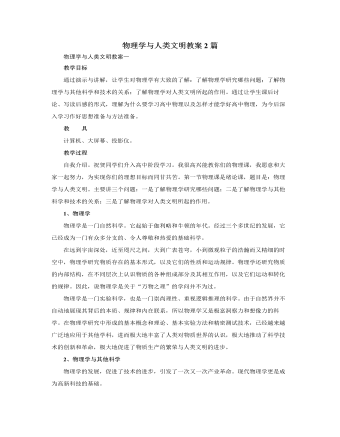
人教版新课标高中物理必修1物理学与人类文明教案2篇
八、物理学的基础地位及物理学对人类文明、社会进步的影响。(1) 情景一:磁悬浮实验:找两个空心的圆柱片磁铁,同名磁极相对,穿在同一根竹筷上,用手压下上面的磁铁,松手观察它的运动情况。问题1:上面的磁铁为什么会跳起来,为什么会悬浮在下面的磁铁上方?问题2:根据这个实验,你会想到那一种交通工具?总结:人们就是从磁悬浮现象中得到启发,进行磁悬浮列车的研究和制造的,这说明物理学在推动社会进步、人类文明方面起到推动作用。(2) 情景二:感应起电和火花放电实验:用感应起电机或感应圈产生火花放电,让学生观察现象,闻气味,然后联想生活实例。还可以用一张纸试着挡住放电的弧光,最好能引燃纸张,说明雷击引起火灾的现象。问题1:你看、听到了什么现象?问题2:根据这个实验,你会想到那一种自然现象?问题3:放电发生在什么地方?为什么建筑物上方都有尖尖的设置,是干什么用的?问题4:你闻到什么气味了吗?
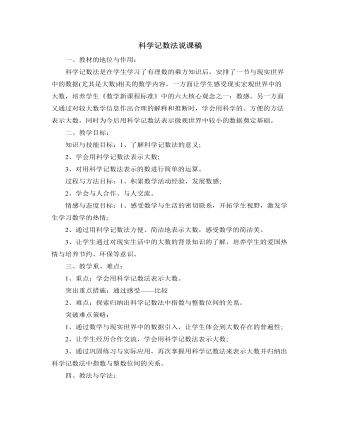
北师大初中数学七年级上册科学记数法说课稿
[设计说明]:只给出情景故事,感知了一个大数,这样还不能引起学生对大数的深刻认识,所以再给出宇宙星空中的这些大数,让学生读读、看看这些数,引起学生强烈的认知上的冲突,形成一种心理上的想读、想写的求知欲望。(二)、引出问题、探索新知在上面的例子中,我们遇到了几个很大的数,看起来、读起来、写起来都不方便,有没有简单的表示法呢?分以下步骤完成。1、回忆100 ,1000,10000,能写成10( )2、300=3×100=3×10( )3000=3×1000=3×10()30000=3×10000=3×10()3、再由学生完成上面4个例子中的数的表示。(学生对160 000 000 000这个数可能表示为、16×1010,教师要利用学生这种错误,强调a的范围)4、教师给出科学记数法表示:a×10( )(1≤a<10)。[设计说明]:通过层层递进的探究设计,启发学生成功地发现“科学记数法”的表示方法,同时又通过学生示错,让学生记住a的范围,体现了以学生为主的探究式教学。
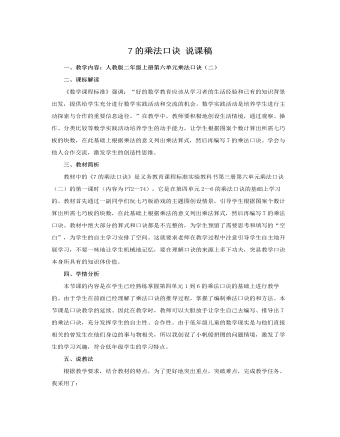
人教版新课标小学数学二年级上册7的乘法口诀 说课稿
在课堂上,我通过点播和启发,充分调动学生的主体意识,让学生体会成功的喜悦。在这里放手让学生找规律,顺势而导地将其引向“精彩”,使课堂教学在“预设”与“生成”的融合中放出异彩。当然了,更重要的是培养学生掌握找规律的数学思考方法,发展了数学能力。在记忆口诀之前,我让学生找找口诀中的规律,然后让学生运用自己发现的特点去记忆口诀,这样学生就不会感到枯燥疲惫,而会主动积极的去记忆,让学生感到自己才是学习的主人。课堂上我还设计了《西游记》中的一段故事情节帮助记忆口诀,通过有趣的人物形象,大大地激发了学生对口诀的兴趣。对于特别难记的口诀,让学生讨论交流、寻找规律,有效地激发孩子的探究心和创造欲,学生想出了联系上、下句记忆,或者用以前学的乘法口诀进行记忆等方法。(四)分层练习,由浅入深。这里的练习主要分基本练习及拓展性综合练习(解决实际问题)两类。首先,通过对口令、口算练习,进一步巩固口诀。

人教版新课标小学数学二年级上册6的乘法口诀 说课稿2篇
2、教材所处的地位和重、难点:表内乘法是学生学习乘法的开始,它是学生今后学习表内除法和多位数乘、除法的基础。教材内容的呈现是在学生学“2—5的乘法口诀”以后。由于他们已经具有学习2—5的乘法口诀的基础,所以教材的呈现形式没有给出一个完整的乘法算式和一句完整的口诀,意在让学生主动探索归纳出6的乘法口诀。体现了提高学生学习独立性要求的编写意图。熟练口算表内乘法,是每个学生应具备的最基本的计算能力。因此,本课的重点应该是让学生理解6的乘法口诀的形成过程;难点是怎样去熟记并利用乘法口诀来解决生活中的实际问题。3、教学目标:①通过观察、探索,使学生知道6的乘法口诀的形成过程。②通过教学活动,培养学生观察能力、判断能力、合作交流和语言表达能力。③让学生体验生活中处处有数学,会用数学知识解决生活中的问题。
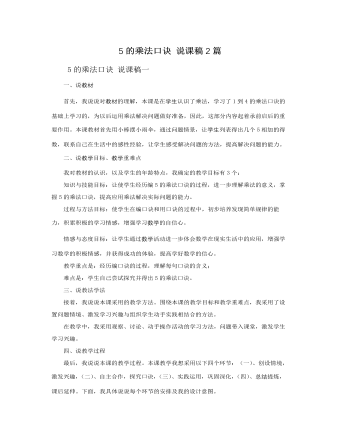
人教版新课标小学数学二年级上册5的乘法口诀 说课稿2篇
二、说教学目标、教学重难点我对教材的认识,以及学生的年龄特点,我确定的教学目标有3个:知识与技能目标:让使学生经历编5的乘法口诀的过程,进一步理解乘法的意义,掌握5的乘法口诀,提高应用乘法解决实际问题的能力。过程与方法目标:使学生在编口诀和用口诀的过程中,初步培养发现简单规律的能力,积累积极的学习情感,增强学习数学的自信心。情感与态度目标:让学生通过数学活动进一步体会数学在现实生活中的应用,增强学习数学的积极情感,并获得成功的体验,提高学好数学的信心。教学重点是:经历编口诀的过程,理解每句口诀的含义;难点是:学生自己尝试探究并得出5的乘法口诀。三、说教法学法接着,我说说本课采用的教学方法。围绕本课的教学目标和教学重难点,我采用了设置问题情境、激发学习兴趣与组织学生动手实践相结合的方法。
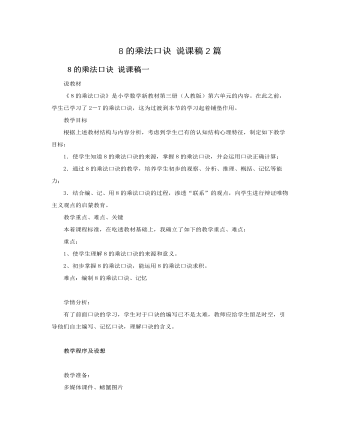
人教版新课标小学数学二年级上册8的乘法口诀 说课稿2篇
《8的乘法口诀》是《义务教育课程标准实验教科书数学》二年级上册的内容。乘法口诀是学生学习乘法的开始,它是学生今后学习表内除法和多位数乘、除法的基础。教材的呈现是在学生学了“2——7的乘法口诀”以后,所以教材呈现形式没有给出一个完整的乘法算式和一句完整的口诀,意在让学生主动归纳出8的乘法口诀。体现了学生学习独立性要求的编写意图。熟练口算表内乘法,是每个学生应具备的最基本的计算能力。因此,本课的重点应该是让学生理解8的乘法口诀的形成过程;难点是怎样去熟记并利用乘法口诀来解决生活中的实际问题。基于对教材的理解,我把教学目标定为:(1)认知目标:通过观察、探索,使学生知道8的乘法口诀的形成过程。(2)能力目标:通过教学活动,培养学生的观察能力、判断能力、合作交流和语言表达能力。(3)情感目标:激发学生的学习兴趣,让学生体验生活中处处有数学,会用数学知识解决生活中的问题。
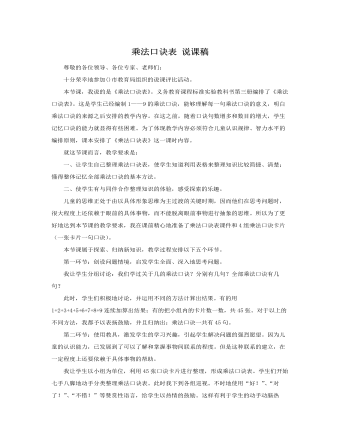
人教版新课标小学数学二年级上册乘法口诀表 说课稿
1、横着看乘法口诀表的规律。(1)第几行就是几的乘法口诀。(2)几的口诀就有几句。(3)第一句都从一开始,几的口诀到几为止。2、竖着看乘法口诀表的规律。(1)从第一竖行到第九竖行的口诀句数是从9——1的顺序出现的。(2)第一竖行是“一个几”,第二竖行是“两个几”……第几竖行就从“几”开始。(3)每一竖行都是到9为止。归纳出乘法口诀表规律后,我让集体分别按横行、竖行各读一遍口诀表。增加学生记忆乘法口诀表。第四环节:利用教学内容渗透思想教育。激发学生热爱科学的激情。我向学生说明:乘法口诀在我国两千多年前就有了。那时是从“九九八十一”开始的,所以也叫“九九歌”。七百多年前才倒过来,从“一一得一”开始。第五环节:布置作业。用自己喜欢的方式背诵乘法口诀表。
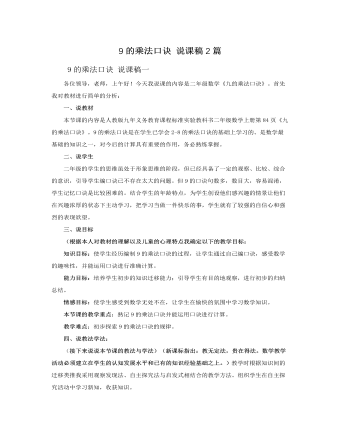
人教版新课标小学数学二年级上册9的乘法口诀 说课稿2篇
(第三的环节)观察比较,巧妙记忆(英国的社会学家斯宾塞说:教育中应该尽量鼓励个人发展的过程。应该引导儿童自己进行探讨,自己去推论。给他们讲的应该尽量少些,而引导他们去发现的应该尽量多些)首先让学生独立观察,再把记忆口诀的好方法跟小组的成员说一说。接着让学生把自己的好方法和大家一起分享:有学生说:“我的方法是积的十位比几个9的几少1,个位加十位等于九,所以个位是9减十位上的数。比如:6乘9,积的十位就是5,个位是9减5就是4。”还有学生说:“我的方法跟他的不同,我用的方法是:几个9就跟几十比,有几十减几。比如:4乘9,跟40比,用40减4就是36。分享了同学的好方法我指导学生手指记忆口诀的方法。接着让学生用你喜欢的方法试背口诀。然后我还采用师生对口令,同桌对口令,男女生比赛对口令方式进行练习。
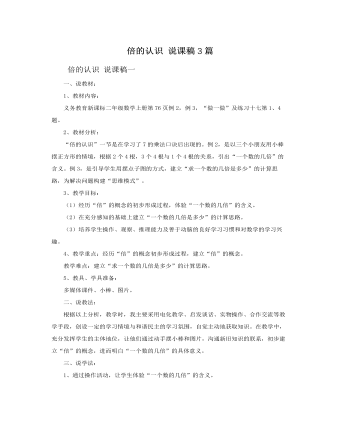
人教版新课标小学数学二年级上册倍的认识 说课稿3篇
二、说教法:根据以上分析,教学时,我主要采用电化教学、启发谈话、实物操作、合作交流等教学手段,创设一定的学习情境与和谐民主的学习氛围,自觉主动地获取知识。在教学中,充分发挥学生的主体地位,让他们通过动手摆小棒和图片,沟通新旧知识的联系,初步建立“倍”的概念,进而明白“一个数的几倍”的具体意义。三、说学法:1、通过操作活动,让学生体验“一个数的几倍”的含义。2、运用独立思考和合作交流相结合的学习方式,引导学生用简洁的语言有条理地表达自己的思考过程。四、说教学过程:本课教学过程充分依靠教材的编排思路,挖掘教材的编排特点,分以下环节进行教学。(一)创设情境,引入新课。由于倍的概念比较抽象,学生不容易理解,所以本节课创设情境,请3名女同学,6名男同学上台,诱导启发,并说明:男同学是女同学的2倍。这节课就来学习“倍的认识”。使学生对教学内容有熟悉感,为学生创设一种用数学眼光分析观察日常生活问题的能力,激发学习兴趣。
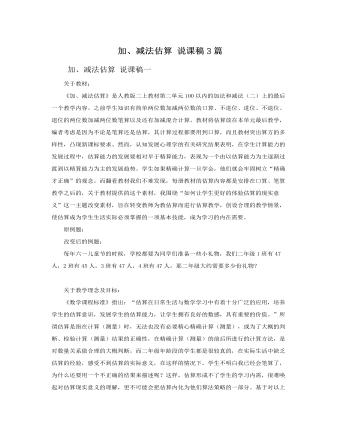
人教版新课标小学数学二年级上册加、减法估算 说课稿3篇
2、自主探究,学习例题(1)猜价格,感受新知课件演示乐乐一家来到商场的情景,让学生分别猜一猜热水瓶、烧水壶和杯子的价钱,在出示杯子的时候,我让学生算一算6个杯子,每个5元,一共需要多少钱?然后老师用一个普通讨论者的口气说:“买一整套会比单买一个要便宜一些,只要24元就可以买到了。”(2)同桌互相交流,培养合作精神先让学生任选两种物品和同桌互相说一说大约需要多少钱?再请个别学生拿着教鞭到黑板前指着自己想买的东西说一说我选了什么,大约多少钱,是怎样估计的。(3)小组讨论,学习例题1)、课件出示例题:妈妈打算买这三种生活用品,100元够吗?2)、学生独立思考,再小组讨论交流;3)、小组总结,汇报结果:请小组代表到黑板上展示学习过程,并引导学生用自己的语言说出估算方法和结果,对不同的方法进行鼓励;

